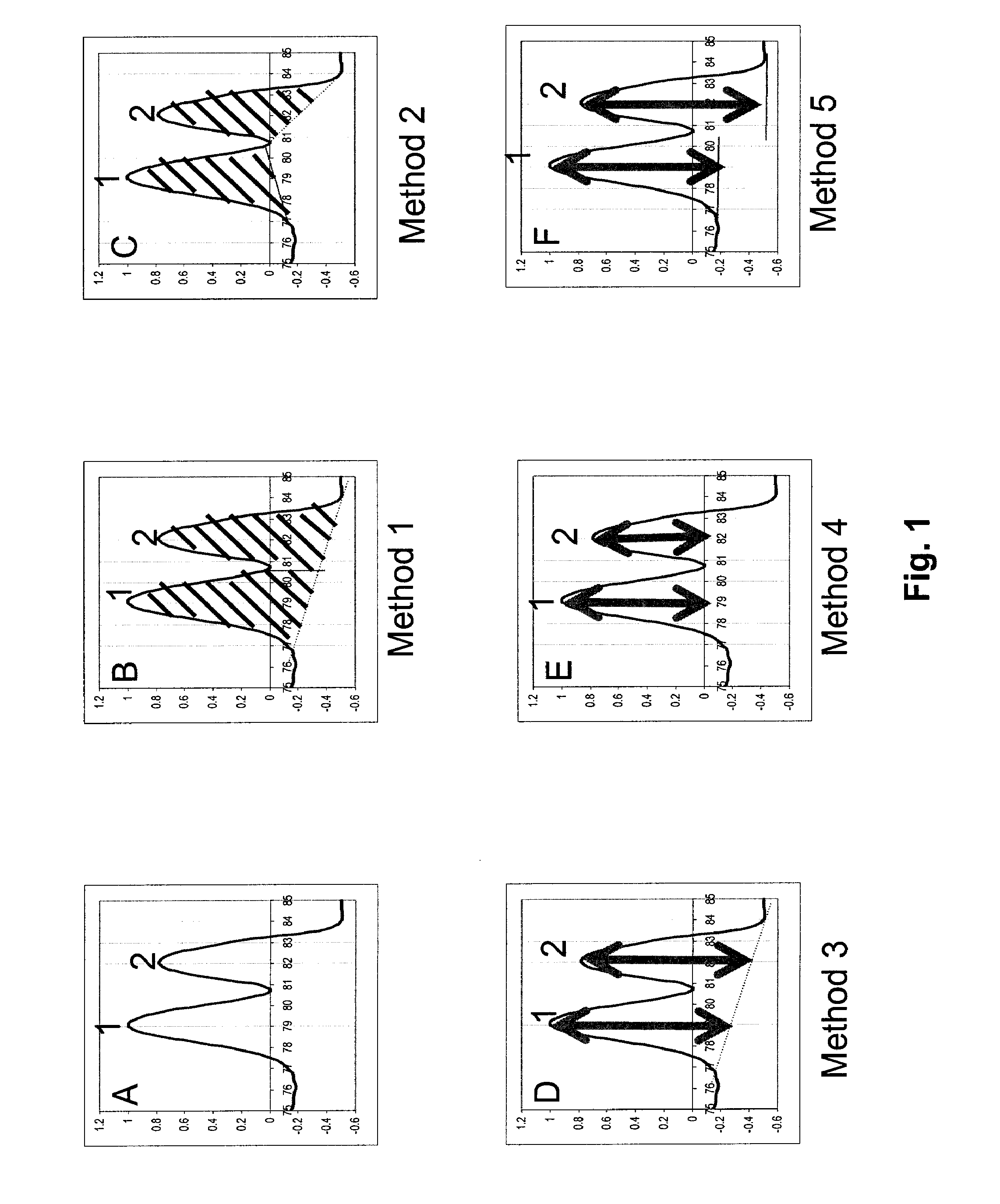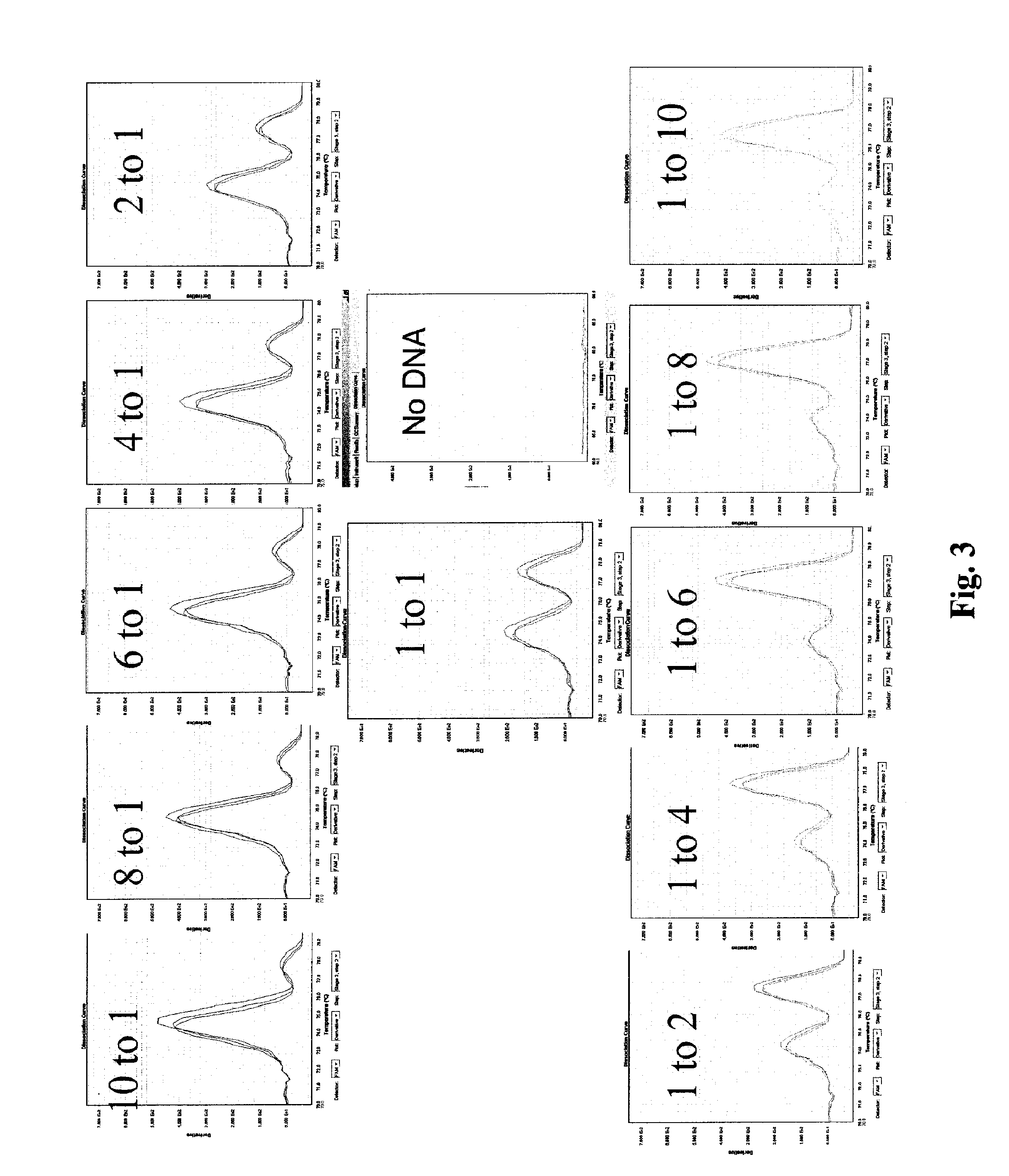Detection and/or quantification of nucleic acids
- Summary
- Abstract
- Description
- Claims
- Application Information
AI Technical Summary
Benefits of technology
Problems solved by technology
Method used
Image
Examples
example 1
Preparation of a Standard of Reference DNA
[0123]In a 20 μL reaction volume, a 10 ng fragment of DNA, which resides in human Chromosome 1, containing the sequence 5′-TGATTCTCTATACCCATTATGACCTGGATATTGGTATTATTGTGGCCATTTCTACCTCAT CACACGTTCTGGAGAATTGT-3′ (SEQ ID NO: 1) was amplified using primers, ChrlF (5′-TTGATTCTCTATACCCATT-3′, SEQ ID NO: 2) and ChrlR (5′-AACAATTCTCCAGAACGTG-3′, SEQ ID NO: 3), in the presence of 1× of EvaGreen® qPCR Basic Mix (Biotium, Hayward, Calif.) and 1 unit of Taq polymerase (Fermentas). The following thermocyle procedure was used for amplification: 95° C. for 4 minutes, 40 cycles of 95° C. for 15 second, 45° C. for 60 second, and 60° C. for 60 second. Standard agarose gel electrophoresis was used to confirm amplification of the DNA fragment. Using standard cloning protocols, the resulting amplified DNA fragment was cloned into pTOPO CRII vector (Invitrogen, Carlsbad, Calif.) to generate the pChrl plasmid.
example 2
Preparation of a Standard of Target DNA
[0124]In a 20 μL reaction volume, al0 ng fragment of DNA, which resides in human Chromosome 8, containing the sequence 5′-ATTTAAACGGATAGTTCTGCAGCCTGAACTTAAATGTTTTCAGGATAAAACAGTTTCAAA
[0125]AATGACTTACCGAAAATCTTCAACTTGTGGCAATGGAATTTTGGAACCTACAGAGCAGTGTGA TTGTGGCTATAAAGA-3′, SEQ ID NO: 4) was amplified using primers, Chr8F (5′-ATTTAAACGGATAGTTCTG-3′, SEQ ID NO: 5) and Chr8R (5′-TCTTTATAGCCACAATCAC-3′, SEQ ID NO: 6) in the presence of 1× of EvaGreen® qPCR Basic Mix (Biotium, Hayward, Calif.) and 1 unit of Taq polymerase (Fermentas). The following thermocyle procedure was used for amplification: 95° C. for 4 minutes, 40 cycles of 95° C. for 15 second, 45° C. for 60 second, and 60° C. for 60 second. Standard agarose gel electrophoresis was used to confirm amplification of the DNA fragment. Using standard cloning protocols, the resulting amplified DNA fragment was cloned into pTOPO CRII vector (Invitrogen, Carlsbad, Calif.) to generate the pChr8 plasmi...
example 3
Copy Number Determination of Target DNA Using Real-Time PCR
[0126]DNA samples from two sets of family trios were purchased from Coriell Cell Repositories (Salt lake city, Utah): Ref NA10846, Ref NAl2144, Ref NA 12145, Ref NA06994, Ref NA07000, Ref NA07029 (see Redon et al, Nature 444:444-454, 2006) and herein denoted as A1, A2, A3, B1, B2 and B3, respectively. Redon et al determined that these sample DNA, A1, A2, A3, B1, B2, and B3 respectively have 3, 2, 3, 3, 4, and 4 copies in a region of Chromosome 8. Target DNA (SEQ ID NO: 4) from example 2 is within the region of chromosome 8 that exhibits copy number variation.
[0127]Each of the six DNA samples (A1, A2, A3, B1, B2, B3) were amplified using 3 sets of primers in 3 separate amplication reactions. All reactions were performed in duplicate. In a 20 μl, reaction volume, al0 ng concentration of each DNA were amplified using 10 μL of 2× 1× of EvaGreen® qPCR Basic Mix HS (Biotium, Hayward, Calif.). For each reaction, 500 nM of one of th...
PUM
| Property | Measurement | Unit |
|---|---|---|
| Temperature | aaaaa | aaaaa |
| Length | aaaaa | aaaaa |
| Size | aaaaa | aaaaa |
Abstract
Description
Claims
Application Information
 Login to view more
Login to view more - R&D Engineer
- R&D Manager
- IP Professional
- Industry Leading Data Capabilities
- Powerful AI technology
- Patent DNA Extraction
Browse by: Latest US Patents, China's latest patents, Technical Efficacy Thesaurus, Application Domain, Technology Topic.
© 2024 PatSnap. All rights reserved.Legal|Privacy policy|Modern Slavery Act Transparency Statement|Sitemap



